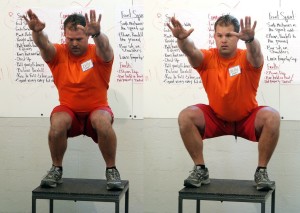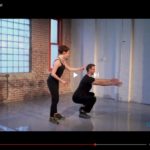I’ve noticed in my immediate fitness environment that there has been a pretty big drive towards more depth in the squat. Everyone, even the casual gym-goer seems to be working at breaking parallel, which I personally think is a good goal, because good movement is key. However, most people I see are overlooking a critical compensation pattern which is ankle collapse.
In A Good Squat The Ankles Have To Look Good
Collapsing ankles, also known as eversion*, look like the demonstration on the left.
Kelly Starrett, author of Becoming a Supple Leopard, which is a great book on mobility, is demonstrating some ankle eversion on the left. (It is actually more of a knee collapse that he is showing, but the ankle component is there as well, especially on his right foot) As you can see, the ankles are pushing in towards the center, bringing the knees with it. In the picture on the right, he has brought the ankles and knees back into alignment.
WE PICKED UP ON ONE THING BUT NOT THE OTHER
I am bringing this up because I’ve noticed a mistake in the general fitness scene. We know about keeping the knees pushed out while going for depth, but we are not doing as well with the ankles. I see a lot of people getting low with good knee alignment, but all the while, the ankles are still falling inward. This is a movement dysfunction that is robbing you of benefits! (Try it: next time you are in the gym watch some different squatters and have a look at their ankles. Do you see them getting mashed inward on the way down?) It’s great to get the depth and to keep the knees out, but if the ankle collapse is happening, you still have a dysfunctional squat and a higher risk for injury.
WHY THIS HAPPENS
There can be a lot of factors for why this might be happening so I will just mention three of the most common. If these things don’t help, you’ll need to work elsewhere. As always, the best bet is to have a qualified person help you out.
1. Lazy Arches – A lot of people have what is commonly referred to as ‘flat feet’, meaning that the bottom has sort of flattened out. This lack of muscular support under the arch of the foot can be a factor. One way to deal with this is to address it at set up. At the top of your squat imagine you are trying to spread the floor out to the sides. (Like standing on two floating blocks and then doing the splits.) If you do this well it should bring your arch up a bit and bring some support to the ankle. Try it unloaded in front of the mirror. Check out this video from Dean Somerset for far more detail, far better explanation, and great tips for improvement.
deansomerset.com/unleashing-your-tibialis-posterior-and-fixing-flat-feet/
2: Stiff Calves – Just about everyone has stiff calf muscles because we walk around on them all day. When this is the case the ankle loses its ability to bend properly. This can mess up your ankle mechanics like crazy. Make sure your ankles are loose and functioning properly. Foam rolling and stretching everyday for a couple of weeks should make a noticable improvement.
2: Weak Glutes – Beginners or casual exercisers often have weak or inhibited glute muscles. These muscles are the main stabilizers for the femur (long bone of the leg). Without femur stability, you are only making it harder to keep your ankles moving properly. You will need to add strength, especially laterally. Try some band walks, bridges, and even sinlge legged deadlifts to help activate and strengthen the area.
IT’S NOT ABOUT THE WEIGHT (DO THE MOVEMENT)
Remember that it’s not about the weight! Don’t pile on the pounds to shove yourself down into a deep squat. Even with the knees out, if your ankles are messed up they will collapse and that will be a problem sooner or later. You should be able to do what Kelly Starret is up to in the picture above – a body weight squat with everything aligned. Ten of those will get your heart rate up and some muscles working if you do it well, so don’t underestimate its power!
Also, check out these articles from Bret Contreras, which is also where I stole the picture from.
General Discussion: http://bretcontreras.com/knee-valgus-valgus-collapse-glute-medius-strengthening-band-hip-abduction-exercises-and-ankle-dorsiflexion-drills/
For the Geeks: http://bretcontreras.com/peoples-knees-cave-inward-squat/
* Collapsing ankles are sometimes also reffered to as pronation, although this is a different process. Falling ankles could be a result of one or both.
http://www.northcoastfootcare.com/pages/Biomechanics.html
One More From Me On Utmost:
Basic Movement Principles For Exercise
* Sometimes you will here people call collapsing ankles pronation, but pronation is a different process – if you would like to geek out about it, click here for a more in depth look.
PHOTOS:
Hamish Darby: Deep Squat, License



Pingback: Knee Collapse While Squatting - do the movement November 3, 2016
[…] Deep Squat + Collapsing Ankles = Poor Squat […]